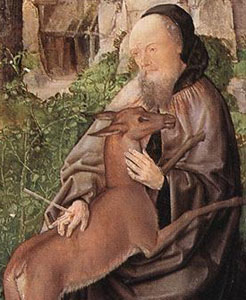The life of Saint Giles, as many mediaeval saints, is steeped in legend. What we do know is that he had quite a following, his popularity attested by the countless places, villages, cities, churches are named after him, including the Italian variant of his name, Egidio. He was a hermit, likely in the 6th century, but perhaps a bit later (there is a story that a secret sin of Charlemagne’s, which the emperor had been too shamed to confess, was revealed to the saint, but that would put Giles two or three centuries beyond his traditional lifespan).
Giles lived in the Rhone valley, renowned for its stunning scenery – the Alps, Lake Geneva, the Mediterranean coast, and all the rest of it – as well as its wines, which the saint likely did not imbibe all that much. In his solitary life in the midst of God’s natural beauty, he befriended a deer, and when the king’s hunters cornered the poor animal, the intended arrow hit Giles instead; although wounded, he lived, making him the patron saint of invalids, along with a host of other ailments for which he is invoked – “childhood fears, convulsions and depression”. As one of the ‘Fourteen Holy Helpers’ – early saints invoked for their particular power against certain maladies, particularly, and originally, the Black Death – Giles is also prayed to for a good confession. He is, curiously enough, the only non-martyr amongst them.
His burial place at Saint-Gilles-du-Gard in southern France was one of the primary sites of pilgrimage up to the 19th century, and continues to be, for some. The abbey still stands, a masterpiece of Romanesque architectural, even if some of it be in ruins (the Huguenots used it as a fort in the Wars of Religion). There must be some solid truth behind all the legends, for such devotion does not spring out of nowhere, and may we pray to the holy hermit Saint Giles today, for whatever ails and needs we have.











